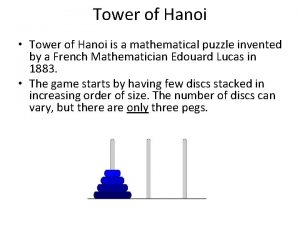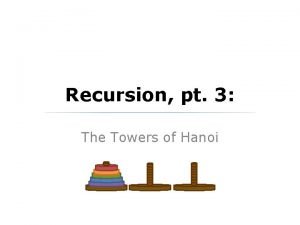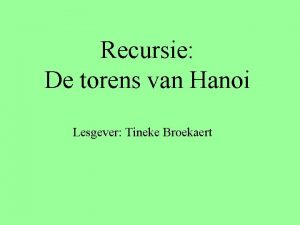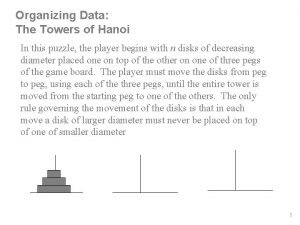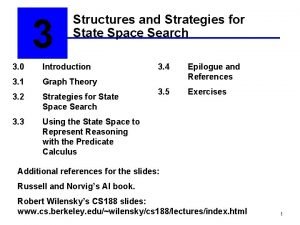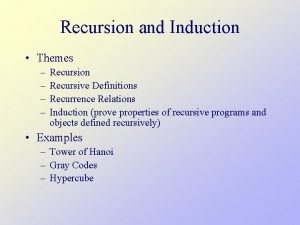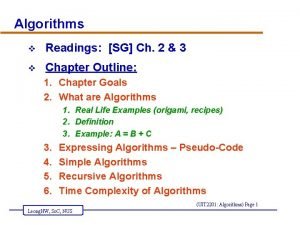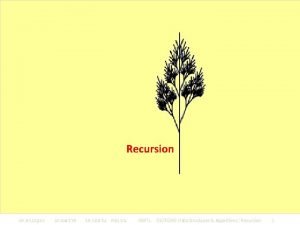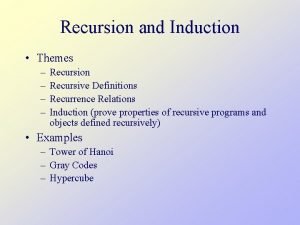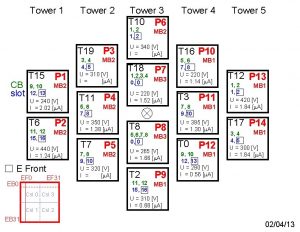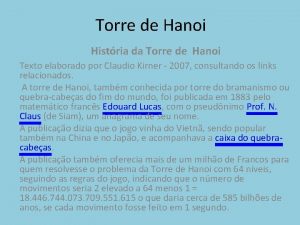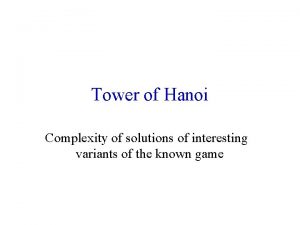Tower of Hanoi Introduction Tower of Hanoi is












- Slides: 12

Tower of Hanoi

Introduction Tower of Hanoi is a very famous game. In this game there are 3 pegs and N number of disks placed one over the other in decreasing size. The objective of this game is to move the disks one by one from the first peg to the last peg. And there is only ONE condition, we can not place a bigger disk on top of a smaller disk.

Notation followed In order to solve we will use a general notation: T(N, Beg, Aux, End) T N Beg Aux End denotes our procedure denotes the number of disks is the initial peg is the auxiliary peg is the final peg Therefore for our example: Objective is: T(3, A, B, C)

Recursive Approach Base Case: T(1, Beg, Aux, End) : Move 1 disk from Beg to End peg. For example: T(1, A, B, C) (Beg -> End) : Move 1 disk from Beg (i. e. A) to End (i. e. C) peg. (A->C)

Try the solve Tower Hanoi Problem for N=2 Solve for T(2, A, B, C) ?

Steps to solve Tower of Hanoi Problem for N=2 T(2, A, B, C) { } T(1, A, C, B) : Move a disk (A->B) T(1, A, B, C) : Move a disk (A ->C) T(1, B, A, C) : Move a disk (B->C)

Recursive Steps T(N, Beg, Aux, End) { T(N-1, Beg, End, Aux) : Move top (N-1) disks from Beg to Aux peg. T(1, Beg, Aux, End) : Move 1 disk from Beg to End peg. (Beg -> End) T(N-1, Aux, Beg, End) : Move top (N-1) disks from Aux to End peg. } Result after T(N-1, Beg, End, Aux) T(1, Beg, Aux, End) T(N-1, Aux, Beg, End)

Solution for N=3: T(3, A, B, C) { T(2, A, C, B) Move top 2 disks from A to B peg. T(1, A, B, C) Move 1 disk from A to C peg. T(2, B, A, C) Move top 2 disks from B to C peg. (A->C) } Result after: T(2, A, C, B) T(1, A, B, C) T(2, B, A, C)

Unfolding the recursion of Tower of Hanoi for N=3 T(3, A, B, C)

Time Complexity Calculate the number of Moves required for various values of N For N=2, Number of Moves = 3 For N=3, Number of Moves = 7 For N=4, Number of Moves = 15 For N=5, Number of Moves = ? ? ?

Time Complexity In general for N disks, the number of moves needed = (2^N) – 1 Hence time complexity is O(2^N)

References https: //www. dyclassroom. com/recursion-algorithm/tower-of-hanoi
